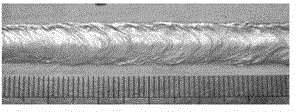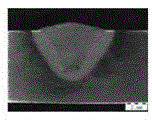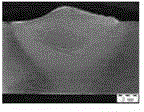A laser-guided gmaw arc composite transverse welding method
A transverse welding, laser-guided technology, applied in laser welding equipment, welding equipment, metal processing equipment, etc., can solve the problems of undercut and weld centerline deviation, etc., to improve welding speed, reduce heat input, eliminate The effect of undercut defects
- Summary
- Abstract
- Description
- Claims
- Application Information
AI Technical Summary
Problems solved by technology
Method used
Image
Examples
specific Embodiment approach 1
[0017] Embodiment 1: A laser-guided GMAW arc composite transverse welding method in this embodiment is carried out in the following steps:
[0018] 1. Degreasing and deoxidizing film treatment of the workpiece to be welded: first wipe the surface of the workpiece to be welded with acetone 2 to 3 times to remove oil, and then use a sodium hydroxide solution with a mass percentage concentration of 6% to 10% to treat the aluminum After soaking the alloy plate for 6 minutes to 12 minutes, rinse it with clean water, and then soak the workpiece to be welded with a nitric acid solution with a concentration of 25% to 35% by mass for 2 minutes to 4 minutes, rinse it with clean water and dry it, and then put the workpiece to be welded The surface to be welded of the part is fixed on the traveling mechanism in a horizontal manner;
[0019] 2. Filling welding wire: The diameter of the welding wire is 1.0mm~1.6mm, the dry elongation of the welding wire is controlled at 10mm~30mm, and the a...
specific Embodiment approach 2
[0025]Specific embodiment two: the difference between this embodiment and specific embodiment one is that in step one, first use acetone to wipe the surface of the workpiece to be welded twice to remove oil stains, and then use a sodium hydroxide solution with a mass percentage concentration of 8% to treat the aluminum alloy. After soaking the board for 9 minutes, rinse it with clean water, and then soak the workpiece to be welded for 3 minutes with a nitric acid solution with a concentration of 30% by mass. Other steps and parameters are the same as those in Embodiment 1.
specific Embodiment approach 3
[0026] Specific embodiment three: the difference between this embodiment and specific embodiment one or two is that the diameter of the welding wire in step two is 1.2mm~1.4mm, the dry elongation of the welding wire is controlled at 12mm~25mm, and the angle α between the welding wire and the normal line is 40 °~65°. Other steps and parameters are the same as those in Embodiment 1 or Embodiment 2.
PUM
| Property | Measurement | Unit |
|---|---|---|
| diameter | aaaaa | aaaaa |
| diameter | aaaaa | aaaaa |
| diameter | aaaaa | aaaaa |
Abstract
Description
Claims
Application Information
 Login to View More
Login to View More - R&D
- Intellectual Property
- Life Sciences
- Materials
- Tech Scout
- Unparalleled Data Quality
- Higher Quality Content
- 60% Fewer Hallucinations
Browse by: Latest US Patents, China's latest patents, Technical Efficacy Thesaurus, Application Domain, Technology Topic, Popular Technical Reports.
© 2025 PatSnap. All rights reserved.Legal|Privacy policy|Modern Slavery Act Transparency Statement|Sitemap|About US| Contact US: help@patsnap.com



